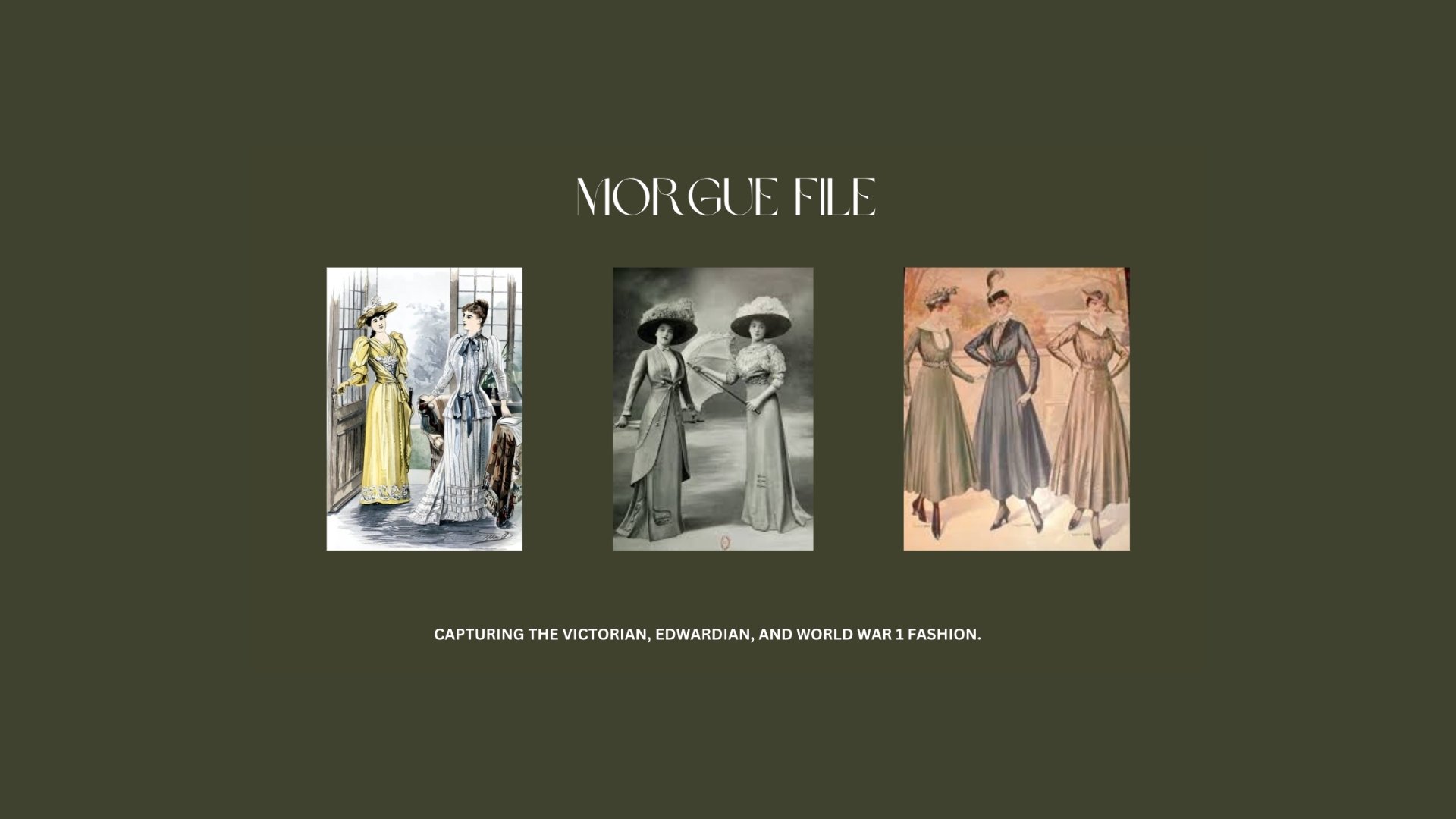Morgue file
The ASK
In a Fashion history course, we were asked to create slide decks for specific sections of history which we then broke down, a women’s and men’s wear overview with overall silhouette of the era defined and a designer contribution overview with identification of one specific trend defined.

Edwardian Era
Womenswear
The Edwardian Era was majorly influences by Alexandra Edward. She was married to Queen Victoria’s eldest son, Albert Edward. Alexandra was a fashion icon as she diminished the use of darker colors and wore more colors specifically pastels. She also favored wearing jewelry and including a lot of sparkles in her everyday attire. One of her largest influences was moving towards less modest fashion which led to the era being called La Belle Epoch (the beautiful era). The Tea dress was extremely popular as it was a thin layered slip that exposed the woman’s pastel colored undergarments. The S bend silhouette was also used often; it featured a bustle but it was cute differently to make the waist look smaller and the body to flow out from the top and bottom. This was often paired with trumpet style skirts which were tight at the top and flow out towards the bottom hem.
Menswear
Menswear during the Edwardian Era was pretty much the same to the Victorian Era with minor changes. Menswear became influenced by the changes in women’s fashion through the new pastel color palletes and by the popularization of sports. Men were expected to be well-groomed with a mustache, no creases in their trousers, and to have a great standing posture. The frock coat was replaced by the sack jacket which was worn with matching trousers. Some of the men’s fashion featured water repellent qualities due to the popularity of sports. The jackets also featured pockets which were created to hold golf balls or other equipment that may be used while playing a sport.
The designer
Charles Worth was still very influential during the Edwardian era, however, he influenced other designers such as Jacques Doucet.
Doucet had similar influence on haute couture and on the business of fashion. He favored exquisite art collections and this passed onto his dress designs. He designed elegant dresses that featured pasttel color pallets and were made with translucent material to work with other designers such as Jacques Doucet. Doucet had similar influence on haute couture and on the business of fashion. He favored exquisite art collections and this passed onto his dress designs. He designed elegant dresses that featured pasttel color pallets and were made with translucent materials.als. He was very well-known due to his designers for famous entertainers.
Victorian Era
Menswear
Menswear during the Victorian Era was very simple. It was largely influenced by Prince Albert as he was in high class at the time. Most men wore similar garments that created the same silhouette. Neutral colors were extremely popular for men to wear such as navy, black, and dark grey. The silhouette included knee length frock coats, waistcoats, shirt with a high collar and possibly a bow, high socks with pointed boots, and trouser pants. The frock coats were mostly seen as being single breasted or double breasted, however, Prince Albert popularized the double breasted version. The silhouette worn by men had the effect to show their bodily structure through padding of their jackets to emphasize their chest.
The designer
Charles Worth was the most influential designer during the Victorian Era. He designed beautiful gowns of all kind and then opened his own business, “House of Worth”.
Not only did he create his own business, but he was known to be the “Father of Haute Couture” and by popularizing the business of fashion. He was able to add embellishments such as gold beading to dresses and adjust the fabrics to fit the customer perfectly.
Worth had a severe impact on ready-to-wear clothing and he revolutionized the idea of designer’s having shown collections. The collection would include several different garments with various details such as beading and they would be shown to attendees.
Womenswear
The Edwardian Era was majorly influences by Alexandra Edward. She was married to Queen Victoria’s eldest son, Albert Edward. Alexandra was a fashion icon as she diminished the use of darker colors and wore more colors specifically pastels. She also favored wearing jewelry and including a lot of sparkles in her everyday attire. One of her largest influences was moving towards less modest fashion which led to the era being called La Belle Epoch (the beautiful era). The Tea dress was extremely popular as it was a thin layered slip that exposed the woman’s pastel colored undergarments. The S bend silhouette was also used often; it featured a bustle but it was cute differently to make the waist look smaller and the body to flow out from the top and bottom. This was often paired with trumpet style skirts which were tight at the top and flow out towards the bottom hem.
The outcome
The outcome of the task is a series of detailed and visually engaging slide decks that provide overviews of women’s and men’s fashion, defining the silhouettes and key elements of specific historical eras. Each deck highlights a notable designer’s contributions and analyzes one significant trend, showcasing its origins and impact. The project demonstrates a strong understanding of fashion history, cultural influences, and visual presentation skills.






